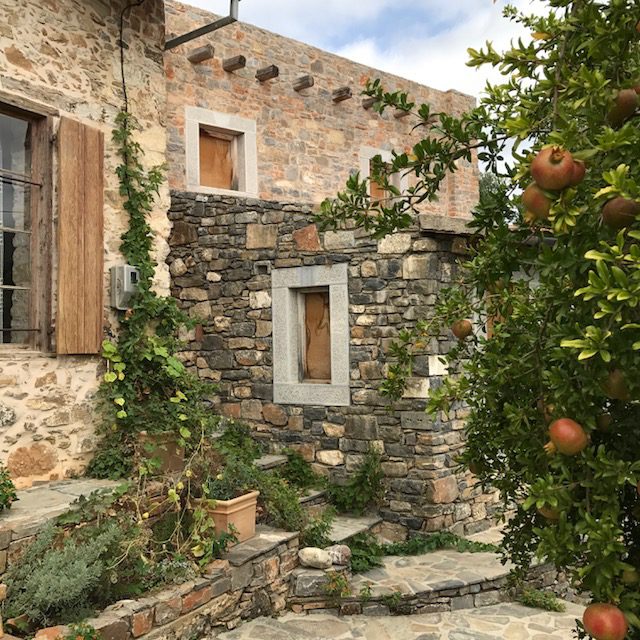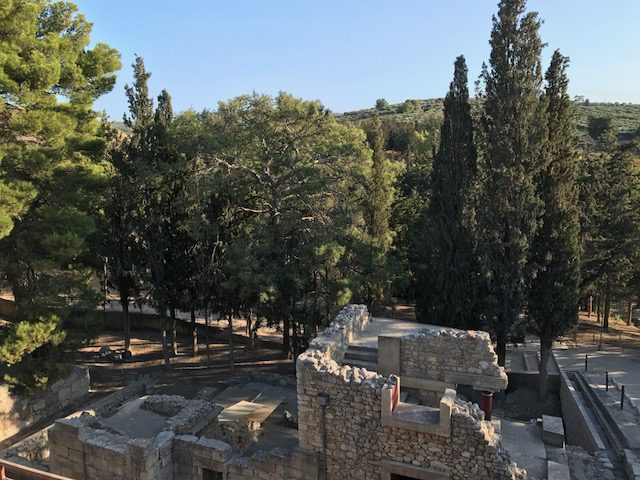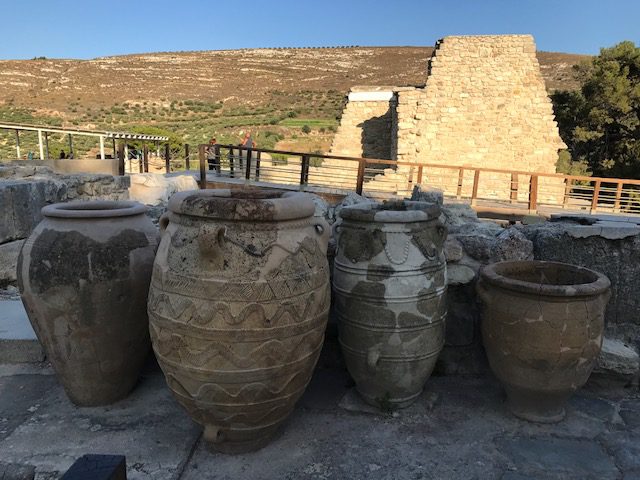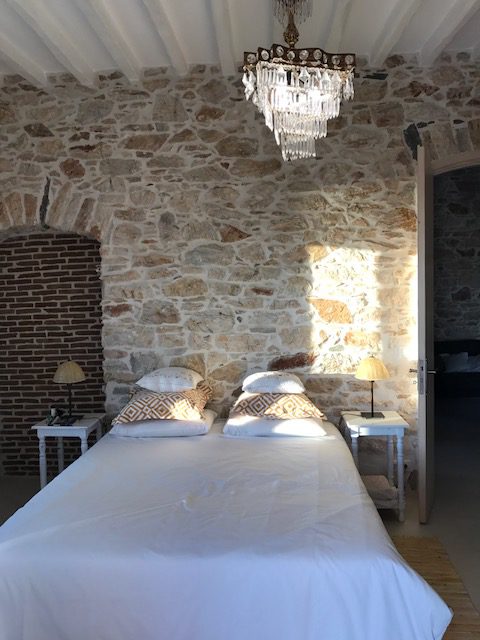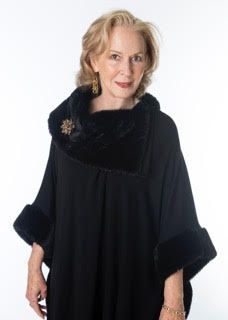The Amazing Blue
Crete, Paros, Syros
Crete
“You should see the landscape of Greece. It would break your heart.”
Lawrence Durrell
More than 2,000 Greek islands, some no larger than a clump of hard soil, rise up out of the blue Aegean. I peer through the window of the airplane that will deliver us to the rocky isle of Crete, the most southerly of the islands. We have chosen a five night stay in a northeastern village, Voulismeni, aiming for the glories of nature and the sea after the intensity of Athens. Crete is a hikers,’ birders,’ and swimmers’ paradise. We pick up a rental car and hit the open road.
This island, birthplace of the 5,000 year old Minoan civilization, is the largest of all the islands. It’s a rocky monolith 160 miles long of soaring snowy mountains stretching along its spine and plunging to deep green valleys, concealing hidden caves, and revealing the Samaria gorge in the south. Everywhere along the coastline either down steep paths or easily accessible beside roads is the lure of sandy beaches lapping with aqua blue waters. I cannot wait to slip into the clear, sparkling water.
After a two hour ride, the owner of the cottage in Voulismeni, Emmanuel, meets us just off the highway. His dirt-streaked car screeches to a stop beside our rental and and he emerges, a Greek Rasputin, thin spindly arms and legs, wild-eyed, shorts hanging off his hips exposing black underwear. “Follow me,” he orders. “We are close.”
Each dusty one-lane rutted track he leads us down is bordered by stunted olive groves beside humble homes where broken chunks of concrete, faggots, plastic bags, cans, beer bottles are wedged into rock walls. Finally, he pulls off the lane and waves us ahead to park. Ahead to what? I wonder. There it is against the hillside, a two-story stone building adjoined to another unfinished stone building, more sheepherder’s hut than cottage. Embroidered white curtains hang in the windows. There is hope, I whisper to Sailor Boy, who never loses hope.
We walk up stone steps onto a stone patio. The depth of each slanted step is higher or lower than the next one. A lone pomegranate tree hanging with pale pink fruit obscures the view of a mountain across the green valley. Emmanuel throws open the door and we walk back 100 years, into a scene I have seen in Zorba the Greek and read about in books—a simple one room Greek dwelling with rock walls, floors, a fireplace. A kitchen is against one wall and a wooden door leads to a bathroom. Above our heads in a loft are questionable sleeping accommodations. A painting of Jesus Christ hangs on the stairway wall. I close my eyes and say a little prayer, knowing full well that my prayer is futile.
With a flourish, Emanuel presents us with his home-made olive oil and when I ask, “Is there a coffee maker?” he’s indignant. “You’ll have Greek coffee. It is easy to make,” he insists, and proceeds to give me a step by step lesson using a briki into which he adds cold water and coffee grounds and places the pot over the flame of a gas burner. Soon the foam of the coffee rises, the smell wafts into the air, and I forget about my prayer. We’ll have Greek coffee, I think, in the quiet of the stone patio, with the birds singing, and the church bell ringing, far far from the maddening crowd.
Later, further down the lane, in the cool of the gathering evening, old people sit in white plastic chairs outside their stone cottages and watch us leaving for dinner. We wave; they wave back. We walk toward the village for dinner in one of the two restaurants that appear to be empty. Along the way, we find a small corner market. The bell on the door tinkles as we enter.
The shopkeeper, a lovely, robust woman, beams. “You are English?” she asks.
“No, no,” we tell her. “Americans.”
“I’m from Thessaloniki.” She laughs. “I married a Greek. That makes me a refugee of love! What do you need? I have everything!”
In the days that follow we meet an English couple in the restaurant to learn they are expats who contentedly live in the village year-round. When the husband, who sports a thin grey pony-tail learns we’re from San Rafael, he peers at us. “Then you know the Grateful Dead?” Our stories trigger his stories, and we part friends in the quick, odd way one does when traveling far from one’s country of origin and meet like souls. We also speak with a lovely Italian couple, Diana Furiassi and her husband, on one of the Blue Star beaches that sport chaise lounges, palm umbrellas, and a cool shower where gentle waves break on the sand and the sea beckons. Diana and I become instant friends as we find out we share the same love of literature and family.
With one day left on Crete, we make a spontaneous decision, saying good bye to the sheepherder’s hut and heading back to Irakleio to a modern hotel and to see the Palace of Knosos. We happen into the last tour of the day with a learned guide who opens our eyes to the wonder of the colossal Minoan site, the wellspring of European culture that lay buried for 3,000 years. The first palace was destroyed by an earthquake in about 1700 BC. Restored between 1900 and 1929 by Sir Arthur Evans, it originally contained 1,000 rooms, many royal apartments, an elaborate drainage system, flushing toilets and paved roads. In Greek mythology, Knosos was believed to the setting of an underground labyrinth designed by Daedalus to imprison the Minotaur. As the last rays of sunset flicker on the frescos, we step over the ancient marble stones, gazing past the tree tops and say good-bye to the Crete that once was and the Crete we have come to know. Other islands are calling across the amazing blue.
Paros
“Most travelers hurry too much…the great thing is to try and travel with the eyes of the spirit wide open, and not to much factual information. To tune in, without reverence, idly — but with real inward attention.”
Lawrence Durrell
Our adventurous spirits take a detour into the temptation of the San Andrea Seaside Resort, on the idyllic little island of Paros. Once we cross the threshold, we don’t leave. The first morning, the sun rises up as if from the blue sea and a man on a braying donkey rides by on a rocky trail in front of the resort. The San Andrea has everything—a room and balcony with an ocean view, a dreamy bed, modern plumbing, and a superlative staff with whom we become friends. The chef turns out delicious food, the bar is open from morning to night concocting enticing drinks, and the guests, from all over the world, prove to be interesting companions. We swim in the cool pool, lie in the sun, snooze, read, and daydream. We share interesting conversations with people from all over the world. Mary and Marco are from Toronto. She’s Greek; he’s Italian. They are traveling with friends and their joie de vie is infectious. Derek, a doctor, is from London. He’s an explorer at heart. Dean, from the Berkshires, has Greek roots. He visits once a year either to see his relatives or to be on his own. One of the staff, Petros, and I share a joke. To everything I ask, he replies, “Perfecto!” to which I respond, “Perfecto!” To leave is both sweet and sad, but leave we must. Syros is calling, the last island on our sojourn in Greece.
Syros
“That house with its remoteness and the islands going down like soft gongs all the time into the amazing blue…”
Lawrence Durrell
A fat Hellenic ferry laden with cars, motorcycles, goods, supplies and passengers motors into the town of Ermoupoli on Syros, the capital of the Cyclades Islands. The ferry throws down its steel tongue and docks. We stumble out, dragging our suitcases, along with hundreds of others into the capital of the Cyclades that looks more Venetian than Greek. No wonder. Ruled since ancient times by Romans, Arabs, Ottoman Turks, Franks, until the 13th century when the Venetians developed Syros as the most important trade center of the Eastern Mediterranean, it remained under the protection of Rome for over 500 years. Today it’s economy is strong in shipbuilding and manufacturing, and unlike many of the other islands it is independent from tourism.
We have booked a stone villa in the southeast of the island in a rural village, Poseidonia, through a fine website called Good Life Greece. We are not to be disappointed. Our host, Nick Geronimos, greets us at the dock and whisks us across the island. We are instantly charmed by his knowledge and bon homie. As he pulls abreast of their restored brilliant white and cream stone edifices, a feeling of contentment washes over me. This is the Greece I had hoped to find.
The villas occupy a gentle sloping hillside amongst vineyards, gardens, and olive trees. A horse whinnies from a pasture below. The view from the patio is to the sea, and out every window and door, the sky is a pure blue expanse. Nick and his gracious wife, Elspeth, have stocked the refrigerator with fruit and vegetables from the garden, wine from Nick’s cellar, and bread and cheese from the village.
In the days to come our son, Jeff, and his wife, Melissa, and our grandchildren, Kat and Sarah, will join us. We’ll swim from sandy beaches where the girls will play in the shallows for hours. We’ll visit Ermoúpoli to see it’s fine opera house and city hall. We’ll join Nick and Elspeth for a dinner under the stars on the terrace with their charming friends. Elspeth will prepare a delicious tomato salad, curry, and cauliflower melange for our enjoyment. Nick will introduce us to both red and white Greek vintages, their taste and refinement undiscovered until that moment. But it will be in the time that I will find myself by myself, in the serene and luminous light of this island in this place, the islands going down like soft gongs into the amazing blue.




